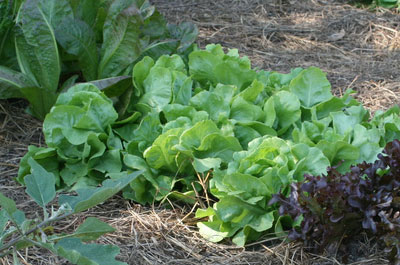Lettuce (Lactuca sativa) is a cool-season vegetable planted in early fall or early spring in Georgia. Lettuce enjoys cool temperatures and can even tolerate a light frost, but extremely cold or hot weather will cause it to perish. Choose an area that receives at least eight to ten hours of sunlight per day.

You can grow lettuce on a wide range of soils, but it grows best on fertile sandy loam soils. Like many other garden crops, lettuce prefers a slightly acidic soil with a pH of 6.0 to 6.5.
Lettuce is an excellent candidate for growing in raised beds or containers. When growing in containers, make sure the container has drainage holes.
You can either direct seed lettuce or use transplants.
Start by preparing the seedbed by tilling to a depth of 8 to 10 inches and removing any large soil clods, sticks or stones. In the absence of a soil test, incorporate 3 to 4 pounds of 5-10-10 fertilizer per 100 square feet of garden area. Smooth the planting area carefully, as a well-prepared seedbed is essential.
Space transplants 10 to 12 inches apart in rows that are 18 to 24 inches apart. Direct seeded lettuce can be planted in rows or broadcast over the entire bed. If you broadcast the seed, thin plants to allow space between plants.
Keep the seedbed moist but not soggy for the first two weeks.
Lettuce seed is very tiny. Place the seed in the seedbed at a depth of 1/8 to 1/4 inch. Lightly firm the planting area with your hand or a hoe.
Irrigate lettuce every four to five days as needed to keep the plants healthy and producing. Lettuce grown in raised beds or containers will need to be irrigated more frequently.

A lack of moisture can sometimes cause lettuce leaves to taste bitter. Drip irrigation or soaker hoses are the best way to irrigate, but overhead irrigation can also be used.
After the initial fertilizer application at planting, apply 2 pounds of 5-10-15 per 100 square feet of bed each month during the growing season. If a soil test has been taken, follow those recommendations.
Harvest the older, outer leaves as soon as they are large enough to use. Such harvesting can occur as the plants mature. If fully developed plants become too crowded, pull out every other plant to leave more room for the others.
Several types of lettuce can be grown in the home garden.
For more information on growing lettuce and other vegetables, contact me.
For more information, visit the links below.
Home Garden Lettuce, UGA Extension, Bob Westerfield and Adrianne Todd
This information was originally published in the The Courier Herald newspaper on September 1, 2021.